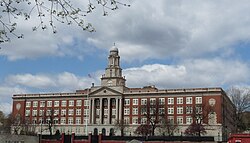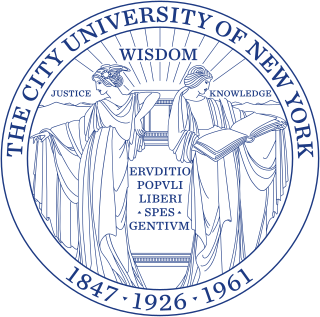
The City University of New York is the public university system of New York City. It is the largest urban university system in the United States, comprising 25 campuses: eleven senior colleges, seven community colleges, and seven professional institutions. While its constituent colleges date back as far as 1847, CUNY was established in 1961. The university enrolls more than 275,000 students and counts thirteen Nobel Prize winners and twenty-four MacArthur Fellows among its alumni.

Ozone Park is a neighborhood in the southwestern section of the New York City borough of Queens, New York, United States. It is next to the Aqueduct Racetrack in South Ozone Park, a popular spot for Thoroughbred racing and home to the Resorts World Casino & Hotel. Traditionally home to a large Italian-American population, Ozone Park has grown to have many residents of Caribbean, Hispanic, and Asian backgrounds.
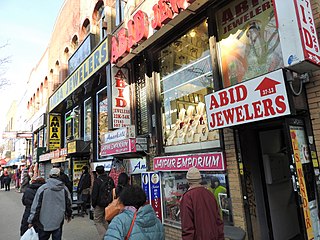
Jackson Heights is a neighborhood in the northwestern part of the borough of Queens in New York City. Jackson Heights is neighbored by North Corona to the east, Elmhurst to the south, Woodside to the west, northern Astoria (Ditmars-Steinway) to the northwest, and East Elmhurst to the north and northeast. Jackson Heights has an ethnically diverse community, with half the population having been foreign-born since the 2000s. The New York Times has called it "the most culturally diverse neighborhood in New York, if not on the planet." According to the 2010 United States Census, the neighborhood has a population of 108,152.

Erasmus Hall High School was a four-year public high school located at 899–925 Flatbush Avenue between Church and Snyder Avenues in the Flatbush neighborhood of the New York City borough of Brooklyn. It was founded in 1786 as Erasmus Hall Academy, a private institution of higher learning named for the scholar Desiderius Erasmus, known as Erasmus of Rotterdam, a Dutch Renaissance humanist and Catholic Christian theologian. The school was the first secondary school chartered by the New York State Regents. The clapboard-sided, Georgian-Federal-style building, constructed on land donated by the Flatbush Reformed Dutch Church, was turned over to the public school system in 1896.

Bushwick is a neighborhood in the northern part of the New York City borough of Brooklyn. It is bounded by the neighborhood of Ridgewood, Queens, to the northeast; Williamsburg to the northwest; East New York and the cemeteries of Highland Park to the southeast; Brownsville to the south; and Bedford–Stuyvesant to the southwest.
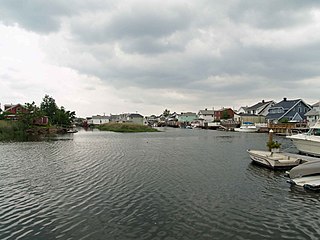
Howard Beach is a neighborhood in the southwestern portion of the New York City borough of Queens. It is bordered to the north by the Belt Parkway and Conduit Avenue in Ozone Park, to the south by Jamaica Bay in Broad Channel, to the east by 102nd–104th Streets in South Ozone Park, and to the west by 75th Street in East New York, Brooklyn. The area consists mostly of low-rise single-family houses.

Woodhaven is a neighborhood in the southwestern section of the New York City borough of Queens. It is bordered on the north by Park Lane South and Forest Park, on the east by Richmond Hill, on the south by Ozone Park and Atlantic Avenue, and the west by the Cypress Hills neighborhood of Brooklyn.

East New York is a residential neighborhood in the eastern section of the borough of Brooklyn in New York City, United States. Its boundaries, starting from the north and moving clockwise, are roughly the Cemetery Belt and the Queens borough line to the north; the Queens borough line to the east; Jamaica Bay to the south, and the Bay Ridge Branch railroad tracks and Van Sinderen Avenue to the west. Linden Boulevard, Pennsylvania Avenue, and Atlantic Avenue are the primary thoroughfares through East New York.
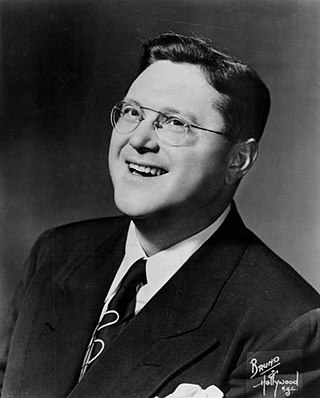
Samuel Levenson was an American humorist, writer, teacher, television host, and journalist.
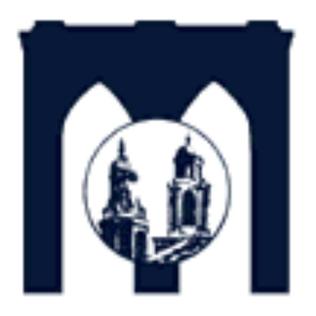
Midwood High School is a high school located at 2839 Bedford Avenue in Brooklyn, New York City, administered by the New York City Department of Education. It has an enrollment of 3,938 students. Its H-shaped building, with six Ionic columns and a Georgian cupola, was constructed in 1940 as part of the Works Projects Administration.

Jamaica High School was a four-year public high school in Jamaica, Queens, New York. It was operated by the New York City Department of Education.

Ocean Hill is a subsection of Bedford–Stuyvesant in the New York City borough of Brooklyn. The neighborhood is part of Brooklyn Community Board 16 and was founded in 1890. The ZIP code for the neighborhood is 11233. Ocean Hill's boundaries start from Broadway and the neighborhood of Bushwick in the north, Ralph Avenue and the neighborhoods of Bedford-Stuyvesant proper and Crown Heights to the west, East New York Avenue and the neighborhood of Brownsville to the south, and Van Sinderen Avenue and the neighborhood of East New York to the east.
The Specialized High Schools Admissions Test (SHSAT) is an examination administered to eighth and ninth grade students residing in New York City and used to determine admission to eight of the city's nine Specialized High Schools. An average of 25,000 students take the test to apply to these schools and around 5,000 are accepted. The test is given each year in October and November, and students are informed of their results the following March. Those who receive offers decide by the middle of March whether to attend the school the following September. The test is independently produced and graded by American Guidance Service, a subsidiary of Pearson Education, under contract to the New York City Department of Education.

Bayside High School is an American public high school located in the Bayside neighborhood of the New York City borough of Queens. It is administered by the New York City Department of Education.

Far Rockaway High School was a public high school in New York City, at 821 Bay 25th Street in Far Rockaway in the borough of Queens. It operated from 1897 to 2011. Its alumni include three Nobel Prize laureates and convicted fraudster Bernard Madoff.

Samuel J. Tilden High School is a New York City public high school in the East Flatbush section of Brooklyn, New York City. It was named for Samuel J. Tilden, the former governor of New York State and presidential candidate who, although carrying the popular vote, lost to Rutherford B. Hayes in the disputed election of 1876.
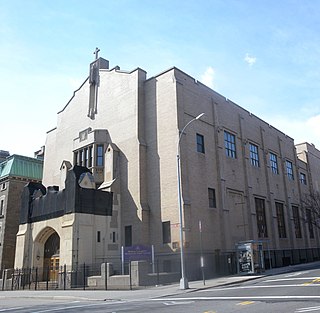
Bishop Loughlin Memorial High School is a private, Roman Catholic, co-educational, college-preparatory high school located at 357 Clermont Avenue in the Ft. Greene neighborhood of Brooklyn, New York. The school serves students in grades 9 through 12. Loughlin was founded in 1851 and was the first high school in the Diocese of Brooklyn (1853), but today is run independently by the Christian Brothers in the Lasallian educational tradition.

Springfield Gardens High School was a public 4–year high school located in the Springfield Gardens section in the New York City borough of Queens. The school was opened in 1965. Closed in 2007, The Springfield Gardens High School building is now a complex made up of four other schools named Springfield Gardens Educational Campus. The schools are named Preparatory Academy for Writers, Queens Preparatory Academy, Excelsior Preparatory High School, and George Washington Carver High School for the Sciences.

The Grand Street Campus is a building used as the home for three high schools in Williamsburg, Brooklyn, New York City. The current building at 850 Grand Street opened in 1981; its identity as the Grand Street Campus dates to 1996. It is currently the home of The High School for Enterprise, Business and Technology, PROGRESS High School for Professional Careers, and the East Williamsburg Scholars Academy.
Andrew Jackson High School is a defunct comprehensive high school in the Cambria Heights section in southeastern Queens, New York. The school was opened in 1937, and named after former United States President Andrew Jackson. However, the city closed down the school in 1994. At its nadir in the late 1970s, police broke up a heroin-processing factory in the school's basement.
